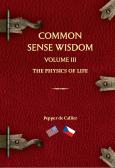How to use this book to change a life
I have spent my life, since age seven, contemplating a very special kind of physics—a kind that literally changes lives. I call it the physics of life. You won’t find this field of physics in academia because, as far as I know, I made it up. A little background on this might be in order.
Today, when we think of physics, most think of names like Kepler, Galileo, Newton, Einstein, Planck, and Hawking. It’s a field that is often associated with complex formulae created by deep-thinkers in laboratories or standing in front of whiteboards filled with numbers and symbols and conjures up concepts of time and space—which is far beyond my depth of understanding.
However, going back to pre-Socratic philosophers such as Thales, the definition of physics sounded much simpler to me. It was a philosophy known as the Study of Nature. The Study of Nature went something like this: Based upon logic and observation a hypothesis was formed and, if proven successful in experimentation, was considered a “truth”.
At the most basic level Thale taught us that physics is about a very powerful, simple concept, the understanding of which could reliably anticipate outcomes. It all came down to the concept of cause and effect.
Fast forward to modern day and to my world of The Physics of Life. It is nothing more than understanding physics in the context of our lives and the link between what we cause to happen and its effect, or outcome. There is something strange about the Physics of Life, though, that is very different from classical physics. In classical physics, effects are driven solely by causes. And, while it’s true that there is a causal link between actions and reactions in The Physics of Life, it is not an absolute. In The Physics of Life, we have the element of choice. We can choose the action, if we are initiating it, and, more importantly at times, we can choose our reaction to actions initiated by things beyond our control—health, economic cycles, the loss of a job, a personal tragedy, past mistakes or failures, etc., etc.
The skeptical response to what you’ve just read is just what mine was many years ago, “No way! There are just too many things in life that we have absolutely no control over.” What changed my mind about this and caused me to create the concept of The Physics of Life, is best summed up by the work of one of the giants of psycho-analysis in the twentieth century, Viktor Frankl. Frankl was a survivor of three internments in Nazi concentration camps in World War II, which is where he formed the foundation of what I feel is one of the most powerful insights into human nature: There may be only one thing that we have control over in life and that is our reaction to our circumstances—how we choose to react to what happens to us. To Frankl’s theory I would add that we also, many times—more than we can readily calculate or immediately understand—have control over what we cause to happen.
So, the theory behind The Physics of Life is based upon a lifetime of personal observation, my personal experience, and my work coaching people around the world for more than 30 years. Here it is: We become the choices we make in life. This is not conjecture. It’s not my hope for a better world. It is a fact, which I have seen play out over and over again in many different cultures, in many different parts of the world. It is not gender, or age-specific. It just is.
In my newspaper column and in magazine articles I have written over the years, I have attempted to distill and illustrate the key concepts of The Physics of Life, by using everyday, easy to understand, real-life examples. This book is a collection of my past columns and articles that evoked the most comments from readers and that I have used in my work with leaders and Boards of Directors.
I did not intend this to be a book that one would sit down and read at one go, although I am not advising against it. My intention was to create a resource that could be referred to at times when one is faced with setbacks, challenges, opportunities, and even success, which can be very toxic if not understood. It is also a book that I truly feel has insights that can change lives—as they have mine—if not yours, someone else’s with whom you interact.
So, please take with you my sincere wish that this book will offer you something of value for your life, your career, and the lives of others.




